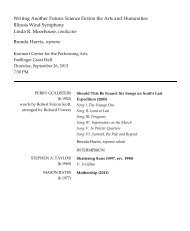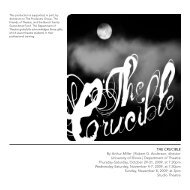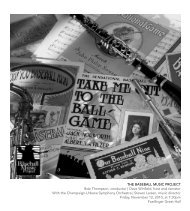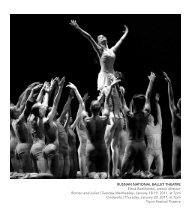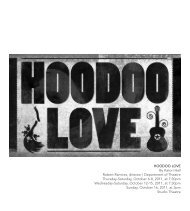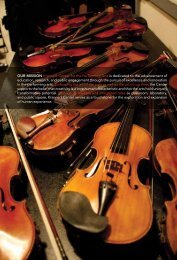Program - Krannert Center for the Performing Arts
Program - Krannert Center for the Performing Arts
Program - Krannert Center for the Performing Arts
Create successful ePaper yourself
Turn your PDF publications into a flip-book with our unique Google optimized e-Paper software.
madrigal developed in Italy and quickly spread north<br />
through Europe to England. In France, madrigals<br />
were known as chansons. Claudin de Sermisy, an<br />
early 16th-century French composer, was recognized<br />
both <strong>for</strong> his chansons and <strong>for</strong> his religious music, as<br />
he held positions with <strong>the</strong> French court under several<br />
kings as well as at La Sainte-Chapelle in Paris.<br />
Sermisy was strongly influenced by <strong>the</strong> Italian frottola<br />
style of composition with its harmonic simplicity,<br />
homophonic texture, and attention to <strong>the</strong> text. This<br />
style is evident in Tant que vivray, as Sermisy uses a<br />
simple harmonic language and subtle text-painting<br />
to tell a beautiful love story. Clément Janequin also<br />
composed in France in <strong>the</strong> early 16th century. Unlike<br />
Sermisy, Janequin never held a position at a<br />
ca<strong>the</strong>dral or a court, and he focused almost<br />
exclusively on chansons. His chansons are most<br />
famous <strong>for</strong> <strong>the</strong>ir programmatic qualities and use of<br />
onomatopoeic effects to imitate natural sounds.<br />
Toutes les nuits, however, does not follow this<br />
pattern. Instead, it expresses in simple tones <strong>the</strong><br />
frustration of a lover who can find his beloved only in<br />
dreams. Claude Le Jeune was one of <strong>the</strong> most<br />
prolific composers of <strong>the</strong> second half of <strong>the</strong> 16th<br />
century. Le Jeune was a member of <strong>the</strong> Académie de<br />
Poésie et de Musique, which was interested, among<br />
o<strong>the</strong>r things, in setting strophic French verses in<br />
ancient classical meters. It is not surprising that this<br />
practice, displayed in <strong>the</strong> rigid meters and florid<br />
rhythms of Revoici venir du printemps, was very<br />
short-lived. Le Jeune’s recurring meters and rhythms<br />
are occasionally ornamented to create a joyous<br />
celebration of spring and love.<br />
Richard Strauss<br />
Born June 11, 1864, in Munich, Germany<br />
Died September 8, 1949, in Garmisch-Partenkirchen,<br />
Germany<br />
Drei Männerchöre, Op. 45<br />
Richard Strauss is best remembered today as <strong>the</strong><br />
composer of strikingly original orchestral tone poems<br />
and operas that continued and extended <strong>the</strong><br />
groundbreaking changes to harmonic language and<br />
musical structure made by Richard Wagner. Strauss<br />
also wrote little-known works <strong>for</strong> <strong>the</strong> male singing<br />
societies of Germany, including Drei Männerchöre,<br />
composed <strong>for</strong> <strong>the</strong> Kölner Männergesangverein in<br />
1935. Though written after <strong>the</strong> height of his prowess<br />
as an operatic and symphonic composer, <strong>the</strong>se<br />
pieces exemplify Strauss’ masterful command of his<br />
musical language and his great sensitivity in setting<br />
<strong>the</strong> poetry of <strong>the</strong> German Romantic poet Friedrich<br />
Rückert (1788-1866).<br />
Von den Türen (At <strong>the</strong> Gates) is a metaphorical<br />
journey through <strong>the</strong> life of one man—from his early<br />
struggle <strong>for</strong> wealth and love to his final resting place.<br />
Traumlicht (Dreamlight) paints an almost<br />
impressionistic vision of light and dreams, while<br />
Fröhlich im Maien (Joyous in May) is a strophic romp,<br />
treating <strong>the</strong> listener to a number of unexpected<br />
harmonic detours and calling on everyone to “dance<br />
. . . joyous in May.”<br />
Steven Sametz<br />
Born in 1954 in Westport, Connecticut<br />
Not an End of Loving<br />
To celebrate 25 years of making music, <strong>the</strong> members<br />
of <strong>the</strong> Lehigh University Choral Union commissioned a<br />
set of pieces from <strong>the</strong>ir director, Steven Sametz, to be<br />
per<strong>for</strong>med by Chanticleer. The pieces were premiered<br />
at Lehigh University in April 2010. Sametz has had a<br />
close relationship with Chanticleer, writing many works<br />
<strong>for</strong> <strong>the</strong> group and conducting it on Claudio<br />
Monteverdi’s Vespers of 1610. In regard to this<br />
collaboration, Sametz shared <strong>the</strong> following remarks:<br />
Chanticleer represents <strong>the</strong> highest levels of<br />
professional choral singing, just as we strive to<br />
achieve <strong>the</strong> highest levels of amateur choral art. At<br />
<strong>the</strong> heart of this—<strong>the</strong> love of singing, and doing<br />
it to our utmost—we have everything in common.<br />
I am deeply honored that <strong>the</strong> Choral Union has<br />
chosen this means of showing its pride in what we<br />
have accomplished over <strong>the</strong> years; creating new<br />
music shows us that <strong>the</strong>re is no end of loving (as<br />
<strong>the</strong> title indicates), especially <strong>the</strong> love that brings<br />
us toge<strong>the</strong>r as singers.<br />
The three pieces of Not an End of Loving are<br />
analogous to ano<strong>the</strong>r work of Sametz’s in<br />
Chanticleer’s repertoire: in time of, recorded on <strong>the</strong><br />
Grammy Award-winning CD Colors of Love. Both<br />
works track <strong>the</strong> passage of time. Not an End of<br />
Loving follows a relationship from its intense<br />
romantic beginnings (Where I Become You) to its<br />
fulfillment of intimacy (We Two Boys Toge<strong>the</strong>r<br />
Clinging) to <strong>the</strong> culmination and release into an<br />
eternal bond (Not an End of Loving).<br />
Eric Whitacre<br />
Born January 2, 1970, in Reno, Nevada<br />
This Marriage<br />
An accomplished composer, conductor, and lecturer,<br />
Eric Whitacre has received composition awards from<br />
ASCAP, <strong>the</strong> Barlow Endowment <strong>for</strong> Music<br />
Composition, <strong>the</strong> American Choral Directors<br />
Association, and <strong>the</strong> American Composers Forum. In<br />
2001, he became <strong>the</strong> youngest recipient ever<br />
awarded <strong>the</strong> coveted Raymond W. Brock Memorial<br />
Commission by <strong>the</strong> American Choral Directors<br />
Association. Commercially, he has worked with such<br />
luminaries as Barbra Streisand and Marvin Hamlisch.<br />
In <strong>the</strong> last 10 years, he has conducted concerts of his<br />
choral and symphonic music in Japan, Australia,<br />
China, Singapore, and much of Europe, as well as at<br />
dozens of American universities and colleges, where<br />
he regularly conducts seminars and gives lectures <strong>for</strong><br />
young musicians. He received his MM in composition<br />
from <strong>the</strong> Juilliard School, where he studied with<br />
Pulitzer Prize winner John Corigliano. This Marriage,<br />
which sets a beautiful love poem by <strong>the</strong> 13th-century<br />
Persian poet Mevlana Jalal ad-Din Rumi, was<br />
composed in 2005 as a gift to Whitacre’s wife,<br />
celebrated soprano Hila Plitmann, on <strong>the</strong>ir seventh<br />
wedding anniversary.<br />
Sir John Tavener<br />
Born January 28, 1944, in London, England<br />
A Village Wedding<br />
English composer John Tavener showed his musical<br />
talents at a young age, becoming remarkably<br />
proficient at organ and piano. He soon turned his<br />
attention to composition and attended <strong>the</strong> Royal<br />
Academy of Music, where he won many major prizes<br />
and awards. In 1965, Tavener’s dramatic cantata The<br />
Whale took <strong>the</strong> London audience by storm at its<br />
premiere, given at <strong>the</strong> debut concert of <strong>the</strong> London<br />
Sinfonietta. Since that time, he has been<br />
commissioned by most of <strong>the</strong> major organizations in<br />
England and <strong>the</strong> United States. Choral music makes<br />
up <strong>the</strong> largest part of Tavener’s works, ranging from<br />
simple carols to large-scale works with orchestral<br />
accompaniment.<br />
Tavener joined <strong>the</strong> Russian Orthodox Church in<br />
1977, and its spirituality, liturgy, and music have had<br />
an impact on many of his compositions. Tavener<br />
notes, “A Village Wedding is a series of musical and<br />
verbal images, describing a village wedding in<br />
Greece. My insertion of Isaiah’s Dance (<strong>the</strong> moment<br />
in <strong>the</strong> Orthodox marriage ceremony when <strong>the</strong><br />
couple is solemnly led three times around <strong>the</strong> Holy<br />
Table by <strong>the</strong> celebrant), and <strong>the</strong> whole tone of<br />
[Angelos] Sikelianos’ poetry, however, show that<br />
everything in <strong>the</strong> natural and visible world, when<br />
rightly perceived, is an expression of a supernatural<br />
and invisible order of reality.”<br />
A Village Wedding was composed in 1992 <strong>for</strong> <strong>the</strong><br />
Vale of Glamorgan Festival of Music, where it was<br />
premiered by <strong>the</strong> Hilliard Ensemble. Chanticleer<br />
gave <strong>the</strong> US premiere in 1995 and recorded it <strong>for</strong> its<br />
Grammy Award-winning album Colors of Love.<br />
8 9




